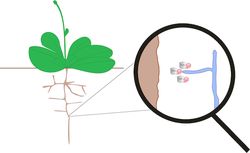Sweet-talk between plants and fungi
Plants are constantly surrounded by fungi that can be detrimental or beneficial. This situation holds true for the aboveground as well as for the belowground tissue of plants. To protect and defend from fungal invaders or to start the symbiosis program, plants need to detect the presence of a microbe. To do so plants take advantage of the presence of microbe-associated molecular patterns (MAMPs) that can be recognized by plant pattern recognition receptors (PRRs). In general a MAMP is a molecule that is i) not present in the plant tissue, ii) crucial for the functioning of the microbial cell and iii) exposed and thus accessible for the plant PRR. Most of the studies on fungal derived MAMPs focused on chitin. Even though chitin represents only a rather low percentage of the total cell wall mass (Fesel & Zuccaro, 2016), this polymer elicits a strong plant response.
In the majority of fungi the most abundant cell wall polysaccharide is β-glucan, a well characterized MAMP in fungus-animal systems. β-glucan is a long fiber consisting of up to 1,000 glucose units that strongly differs in their composition between different fungi. The role of β-glucan as a MAMP in fungus-plant-systems as well as the plants PRR involved in β-glucan recognition remain unclear.
In the lab of Prof. Dr. Alga Zuccaro we study the root colonizing fungus Serendipita indica (formerly Piriformospora indica) and try to understand how β-glucan signaling is involved in this interaction. We are aiming to elucidate the role of β-glucan as a MAMP and therefore based our work on three pillars: I) decipher the exact part of the β-glucan-fiber that is recognized by the plant receptor(s), II) identify the plant receptor(s) that recognizes β-glucan and III) investigate the mechanisms how fungal invaders are able to hide their β-glucan from recognition.
Experimental approach
The model plant Arabidopsis thaliana offers the great potential that more than 1,000 natural accessions are available that differ not only phenotypically but also genetically. Making use of this repertoire will allow us to test different accessions for their defense responses towards fungal invaders and connect this alterations to their genetic background. Another approach involves a labelled substrate as a bait for the enigmatic β-glucan receptor. Once the exact part of the β-glucan fiber that is recognized by the receptor is identified, this substrate can be used to capture the receptor. On the other hand, we want to understand the toolkit employed by fungi to circumvent the recognition by the plant immune system. In order to gain a deeper insight into immune suppression we characterized the newly discovered sugar-binding protein FGB1 (Fungal Glucan Binding 1) of the root endophyte Serendipita indica (Wawra et al., under review). FGB1 is able to bind specifically to β-glucan and prevents its recognition by the plant immune system. Thus FGB1 may be employed by Serendipita indica to prevent recognition of its β-glucan-fibers by the plant receptors.
In general, a better understanding of the molecular mechanisms underlying the interaction of plants with fungi is a prerequisite to promote the use of beneficial fungi in agriculture. Especially Serendipita indica may be of great interest for this purpose since it is able to promote the growth of many different plants and thus may either communicate in many different “languages” to successfully interact with different groups of plants or uses a common “language” that most of the plants understand.
Contribution by Philipp Fesel, Cologne Biocenter
Planter’s Punch
Under the heading Planter’s Punch we present each month one special aspect of the CEPLAS research programme. All contributions are prepared by our young researchers.
Corresponding publications
Fesel, P. H., & Zuccaro, A. (2016). β-glucan: Crucial component of the fungal cell wall and elusive MAMP in plants. Fungal Genetics and Biology. 90: 53-60 doi:10.1016/j.fgb.2015.12.004 [Abstract]
Wawra, S., Fesel, P., Widmer, H., Leson, L., Kesseler, L., Nostadt, R., Hilbert, M., Langen, G. & Zuccaro, A. (in Begutachtung). The novel fungal specific β-glucan binding lectin FGB1 alters susceptibility to cell wall stress and prevents glucan-triggered immunity in plants.
